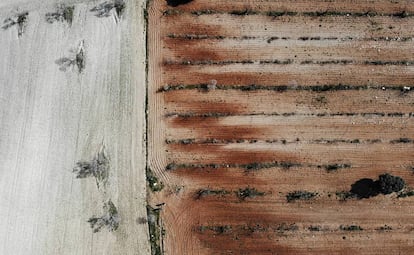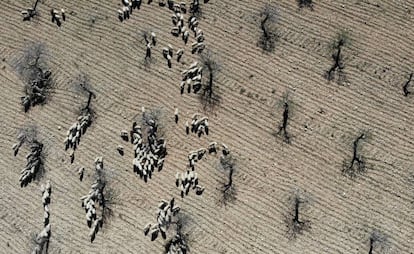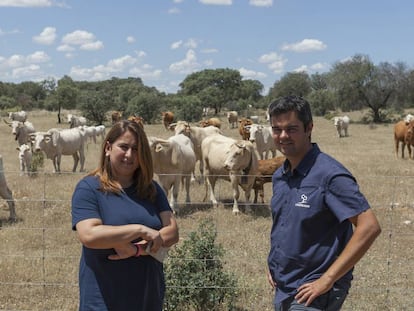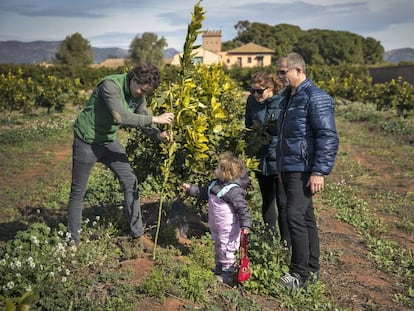The herculean task of pushing back the desert in Spain
Entrepreneurs in Almería, Granada and Murcia have joined forces to restore a huge tract of dry land over a period of 20 years with the help of international investors and philanthropists


The desert creeps forward stealthily. There are few witnesses to the gradual swallowing of fertile land and forests by soil erosion. In regions suffering the worst degradation, the rural population is forced to abandon the land and seek work and opportunities in the city.
In the Spanish interior, in one of the driest parts of Europe, an eco-business movement called Alvelal is attempting to reverse this degradation of biodiversity, or at least to prevent its relentless progression, on a huge tract of land that spans more than one million hectares and is shared by Almería, Granada and Murcia.
This gargantuan task was embarked upon five years ago and still has another 15 years ahead of it at least. It was started by growers and entrepreneurs who are developing regenerative agricultural schemes funded by foreign investors and philanthropists that will nurture the soil and the microbiology that is slowly but surely being annihilated. The returns are not quick, and it will take until 2035 before the €1.3 million annual investment begins to pay off. The renaissance of the soil is, after all, a lengthy process.
“We needed Alvelal [the entrepreneurs’ association]; they really were an answer to our prayers,” says environmentalist Belén Sánchez from the foot of La Muela, the iconic mountain in Vélez Blanco, Almería, that has just had as many as 50,000 holm oaks, Phoenician junipers and Aleppo pines planted on its slopes.
The aim is to empower rural people so they can take charge of their own destinies in a region that is socially and economically challenged Astrid Vargas, conservationist
“This project in Spain will have a massive impact and could even change the local climate, with more water on the soil and more evapotranspiration [from the trees],” enthuses Tim Christophersen, head of the Fresh Water, Land and Climate Branch at UN Environment, based in Kenya.
In late 2014, Commonland, a Dutch NGO, was looking for an area of Spain where it could apply the environmental model it had had so much success with in South Africa and also in Australia. They invited applications from interested parties and finally opted for the plateau of Almería.
The conservationist Astrid Vargas, known for her Iberian lynx breeding program, helped the NGO to sift through the 21 applications along with Andalusian ecologist Paco Casero. The deciding factors were the degree of erosion and depopulation, which has hit the region badly.

“We focused on Spain because the Mediterranean is badly affected and there were already UN reports of progressing deforestation in 2009,” says Commonland CEO Willem Ferwerda. “We were looking for a high plateau that people wanted transformed, and now we have the biggest land-restoration program in Europe.”
“The aim is to empower rural people so they can take charge of their own destinies in a region that is socially and economically challenged,” says Vargas.
These visionaries are attempting to replicate The Great Green Wall of Africa in the Sahel region, where a huge forest stretching across the width of the continent combined with rural development projects could halt the spread of the Sahara and bring swathes of Africa’s degraded landscapes back to life.
This project in Spain will have a massive impact and could even change the local climate Tim Christophersen, head of the Fresh Water, Land and Climate Branch at UN Environment based in Kenya
Just a few kilometers from the desert of Los Colorados, and adjoining the Quaternary Geopark in Granada, the siblings Francisco and Álvaro Martínez are working in extreme conditions to cultivate vegetables, almonds and olives interspersed with aromatic plants. “This is a steppe desert and it has a bad temper,” says Francisco, an agricultural engineer. “There’s frost every night and in the ground, we’ve measured every temperature between 80ºC and -30ºC. Not only that, but just 20 centimeters under the surface, there’s limestone. Those are our working conditions.”
In order to bring nitrogen back to the soil, they have planted several species of grass and leguminous plants for vegetation cover, perfected over the last seven years in order to dispense with the plastic used in greenhouses elsewhere in the region. In 1998, the brothers embraced sustainable agriculture and 10 years ago, they went a step further and became involved with regenerative agriculture, which is concerned with the health of the soil and uses minimal plowing. “My grandfather and my father both used DDT [a toxic pesticide that is now banned] to help them compete with nature,” says Francisco. “But this is about going back to pre-industrial revolution times. We are not even being that clever; a hundred years ago everyone was doing what we are doing.”
The main economic engine
The Amsterdam-based Commonland is the main economic engine behind this land-restoration project. After 17 years heading the International Union for the Conservation of Nature in the Netherlands, Willem Ferwerda founded the NGO, which now attracts €5.2 million in investment directed at environmental projects in 11 different countries. Ferwerda is something of an investment “dowser” who scours the world in search of philanthropists, governments and companies prepared to put money into environmentally conscious projects. “It takes time and you have to be patient, but philanthropists, traditional investors and companies are more easily convinced… Because there is Wall Street and then there is slow capital,” he says.
So why does land restoration take 20 years? “As an environmentalist, I would prefer 30 or 50 years, but investors and investment funds can’t think beyond 20 years. It is the same with investment in highways – the outside is 20 years,” adds Ferwerda. “Sometimes I get businessmen coming to me to invest in isolated projects, but that’s not how the landscape works.”
Land restoration is an ambition Commonland shares with governments across the globe. In 2014, the UN drew up a proposal to recover 350 million hectares of degraded land – an area the size of India – by 2030, requiring an investment of €730 billion. The fact is that two billion hectares of land are currently suffering degradation – an area twice the size of China, according to the World Resources Institute. To alleviate this, the UN’s General Assembly has approved the Decade on Ecosystem Restoration to mobilize political and financial support that will improve the welfare of 3.2 billion people between 2021 and 2030.
“Freeing up private funds is essential, as money from governments will not be enough for the global restoration of ecosystems,” says Tim Christophersen, head of the Fresh Water, Land and Climate Branch at UN Environment. “We are encouraging Commonland to share their experience with other organizations in order to replicate its success in other countries.”
“You might be forgiven for thinking that we have discovered Mars with regenerative agriculture,” says the enologist Juana Reche. “But in days gone by, farmers were aware and wise and they learned from each other. And that is what we are doing; recovering old techniques and spreading the word.”
Andalusia and Catalonia have more soil erosion annually than any other region in Spain, and a fifth of this land loses more than 25 tons of soil per hectare per year, according to the 2017 National Soil Erosion Inventory. “The soil we are currently losing is not renewable,” says Emilio González, an expert from Córdoba University.
The most common crop on the Almería and Granada plateau is almonds as they fetch good prices, but the soil is increasingly poor and furrowed by torrential rains. The organic content of the soil on the plateau’s cultivated area ranges between 0.38% and 1.5%, so much of it falls short of the 1.5% level of organic matter common to dry lands, according to data from Almería University. “This land loses an average of 1.8 mm from its top soil every year – the part that is most fertile – which means 20 tons of soil per hectare,” says Miguel Ángel Gómez, a researcher at Almería University. On top of this, rain has been in short supply over the last few years, ranging between 200 and 400 mm annually.
We needed Alvelal, they really were an answer to our prayers
Belén Sánchez, environmentalist
Besides planting 50,000 trees on the slopes of La Muela, there is a holistic vision to the restoration scheme that encompasses soil erosion, regenerative agriculture, sustainable livestock farming, water conservation and depopulation. To address these issues, investment focuses on business; money is plowed into local companies that show that sustainable development is the only way forward. There has to be profit potential to keep the countryside populated. Planting trees is not enough. Vélez-Blanco had 7,000 residents in 1950 and now it has 2,000. The Vélez district has four inhabitants per square kilometer, a population density below that of Lapland.
Alvelal is focused on a piece of land the size of Madrid planted with more ecological almond trees than anywhere else in the world: 50,000 hectares. The association brings together 250 entrepreneurs and researchers as well as ecologically minded individuals, and receives funds from Commonland and other entities such as the TUI and the Leopold Bachmann foundations to develop alternative and sustainable businesses. Regenerative agriculture covers 8,000 hectares containing 40 farms with tree-based crops out of the total of one million hectares, an area that Alvelal hopes to double in two years. “You are not going to convince a farmer to change his crops to something that is not profitable,” says Elvira Marín, the Alvelal coordinator while Vincent De Leijster, researcher at the Utrecht University in the Netherlands, adds, “Regenerative agriculture with almonds increases the ecological value of the ecosystem services by between 17% and 28% after just one year.”

The first business is already taking off: a company called Almendrehesa is selling its Pepita de Oro brand to markets in the UK and Germany. If traditional almonds fetch around €4.5 a kilo, organic almonds fetch €6.5. Almendrehesa even gives its producers €7.5 a kilo for the very prettiest almonds. There are also companies that are about to start selling olive oil from centuries-old olive groves, essential oils from aromatic plants, wine, honey, beer and organic lamb. “Alvelal wants to give companies with solid proposals and environmental criteria a boost,” says the association’s president Cristóbal Aránega, whose company sells organic fertilizer and employs a staff of 45. The farmer Álvaro Martínez adds: “With Alvelal, you know that there are more people [doing what you are doing] and you feel they’ve got your back.”
Alfonso Chico de Guzmán has come back to the family farm in Murcia after studying business administration, and he now wants to experiment with cereals, almonds, pistachios and aromatic plants. “Regenerative agriculture is like having a 60-year-old shoe factory and changing the factory and changing the shoes and how they are made. But it’s either that or closing the factory,” he says. “Now there are 15 of us and we are already covering costs with a view to expanding.”
Other green angles
“I watched my daughter asking the trees permission every time she picked a piece of fruit, and at the same time I was tired of the lack of environmental awareness in people,” says environmentalist Dolores Masigosa, who has launched a project to nurture the bond between humans and the land after reaching the conclusion that the key is to instill an affinity with the Earth from an early age.
“It has been proven that between the ages of three and 16, you are more likely to relate to your environment through experience,” she says. “Because of a child’s capacity for wonder, a link with nature can be nurtured. And this feeling of being linked to nature is what generates the emotional bond, so respect for the environment becomes innate.”
The project aims to take 33,000 children out of the classroom and, with the help of 3,000 teachers, introduce them to nature over the next five years, thanks to Alvelal and the Savia and Leopold Foundations.
Chico de Guzmán has a land restoration camp on his 1,000 hectare farm, La Junquera, which attracts volunteers from all over the world. He also hosts a Regenerative Academy that takes students – so far all foreign – who are writing their research thesis on agriculture. “The land is pretty degraded but the people have got a lot of energy,” he says. “If you give them a nudge, it goes a long way, like a tree in the desert in need of compost.”
The UN Food and Agriculture Organization (FAO) produced a recent report warning of the loss of biodiversity around the world and the implications for food safety with data from 91 countries. This is exactly the angle tackled by Alvelal. “The more we plowed the the land, the more pests we had,” says Miguel Ángel Martínez from his farm in Venta Quemada, Granada. “When we stopped fumigating, the pests ended.”
Greenpeace believes that the restoration of the Spanish southeast interior region, which covers 76 municipalities, is a good example to follow. “It touches on everything in a cross-disciplinary fashion in order to confront challenges such as climate change, the obliteration of insects and the use of water and soil,” says Luis Ferreirín, who is responsible for agriculture at Greenpeace Spain.
The land is pretty degraded but the people have got a lot of energy. If you give them a nudge, that goes a long way Alfonso Chico de Guzmán, farmer
The European Commission is currently debating the New Common Agricultural Policy (PAC) for 2021-2027, which, according to Greenpeace, should assume the challenge of sustainable food production. So far, the current PAC lacks a holistic vision and only goes as far as to support better agricultural practices that are beneficial to the environment.
Alvelal approached the Ministry of Agriculture in Spain to see whether, as a leader in organic agriculture, the country could also lead in the certification of products from regenerative agriculture in Europe. However, sources from the ministry responded by saying that as things stand now, such certification is not being considered.
So is the plateau project successful enough to take root and make a difference? “There is currently a structure because there is money,” says Paco Casero. “If there is no commitment, that structure will collapse when the money goes. Alvelal should get involved locally, otherwise the social base that daily commitment relies on is not there. And something like this cannot fail, which is why things have to be very transparent.” As spring approaches, there will be a reshuffle in the association to avoid any lack of transparency.
Livestock
Another green angle involves closing the holistic circle of crop diversity, which requires extensive grazing. The livestock breeder Santiaga Sánchez has 1,000 sheep and sells organic segureño lamb, which is 25% more expensive than regular lamb. "Apart from the environmental advantages, I explain to visitors that they will be eating meat that is free from hormones, transgenics and antibiotics," she says.
Sánchez admits there are problems convincing the consumer of the advantages of eating organic meat , as well as distribution challenges. But customers can be sent the meat via messenger service in under 24 hours, wherever they happen to be in the country.
Working in the opposite direction are farmers exacerbating the exploitation of underground water for the mass production of lettuce, a vegetable that needs intensive watering in an area of scant rainfall. Meanwhile, intensive pig-farming outfits are attempting to expand their business model despite the fact that several councils have signed municipal orders banning them on account of the contamination. “The sustainable development model does not include farms with thousands of pigs because it is not compatible with either tourism or with rational water consumption,” says Francisco Torregrosa, mayor of Benamaurel in Granada. “We don’t want to be the dunghill of Spain.”
And while regional governments and local councils often help Alvelal with their projects, they stop short of providing funding.
“Who are we?” asks Aránega. “We are not a union, or an environmental movement nor are we the tractor protest guys, or the water defenders, or the pig farm fighters. Our tools are business models… It wasn’t easy to define ourselves.”
Getting the word out
Alvelal would like to take advantage of the million tourists that come to the coast between Benidorm and Marbella every year and take them inland on a gastronomy tour. Tourists rarely make it beyond Los Letreros caves, but now Alvelal has signed an agreement with TUI, the multinational tour operator, in a bid to increase visits inland.
“It is a project that involves the head, the heart and the stomach,” says Dietmar Roth from Ecosystems Restoration Camps. “It is about attracting the kind of tourist who would like to get to know the real Spain and interact with the local population, as opposed to those baking like sardines in their hammocks.”
The tours could include a visit to the aromatic plantation at the foot of La Muela, which will be ready by next year. Finding inspiration in land art, which uses aromatic plants as material, the herbs form a giant indalo figure – the magical symbol found inside Los Letreros caves – whose tones of green, white and mauve will be visible from afar. “It is a landscape project that is being undertaken by people with disabilities,” says environmentalist Belén Sánchez.
Roth highlights the importance of schemes that help to link locals with the land they live on. “We are trying to get people to see that their land is not a worthless desert. We are talking about self-esteem,” he says while Ángel Hernández adds: “It is self-esteem that was taken away by our own families.”
In early April, Alvelal is organizing a day of rural pride. “We have enormous power as consumers,” says the businessman Manuel Martínez. “It’s important to talk to friends and let them know about the magic of the product. Before, in my village, there was no shop selling organic products, but there is now.”
English version by Heather Galloway.

